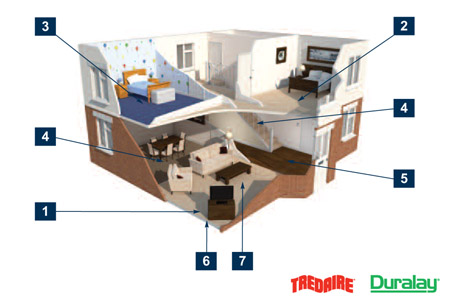
Customers have a wide range of underlay needs. Having the right range to meet these needs will maximise your profits.
Question: How many underlay products should a retailer stock?
Answer: As many as you need to meet the needs of your customers and maximise your opportunity for profit?
It’s an interesting question. What is the right number? Some retailers stock up to seven or eight underlays, while some stock only one. Which is correct and, more importantly, how would you know? The answer, according to Interfloor marketing director Steve Woodhead, is clear. “It depends on your customers. Most underlay customers don’t give underlay much thought but that doesn’t meet they don’t have any needs. It’s just that these needs are often unstated. But they still exist. Some simple questioning will get the answers you need. Once you know what their needs are you can come up with an underlay solution that’s not only perfect for them but will also help you to maximise your profit. In this way everybody wins.”
So how does this work? Interfloor have defined up to seven different needs for underlay in an average British home. These are:
- Best comfort: premium products where luxurious comfort is needed and foot traffic is high (e.g. living rooms). Recommended underlays include Tredaire Dreamwalk, Sensation, Softwalk and Colours Red.
- Better comfort: premium products where luxurious comfort is needed and foot traffic is low (e.g. master bedrooms). Recommended underlays include Tredaire Zest, Brio and Dynamic.
- Good comfort: everyday comfort where foot traffic is low or infrequent (e.g. spare bedrooms). Recommended underlays include Tredaire Brio, Omega, Alpha and Willow Green.
- High traffic / High impact: where foot traffic is really high (such as the hall stairs and landing) or there is a high impact from heavy furniture (typically in the dining room). Underlays with high density and recovery rates are needed for this. Recommended underlays include Duralay System Ten and Treadmore (crumb underlays with 100% recovery) and Tredaire Sensation and Contract 7 (PU underlays with 95-97% recovery).
- Noise reduction underlays for wood and laminate flooring: extremely high density sponge underlays can reduce in-room noise by up to 30%. Recommended underlays include Duralay Timbermate Excel and Silentfloor Gold.
- Low tog underlays for underfloor heating: specially designed low tog underlays are needed for underfloor heating applications. These will need to have tog ratings of less than 1, and so should be specially adapted sponge rubber. Recommended underlays are Duralay Heatflow Carpet (tog 0.75) and Duralay Heatflow Wood and Laminate (tog 0.33).
- Wheelchair use, walking aids, natural floorcoverings or border carpets: double stick crumb rubber underlays are ideal for this. Recommended underlays include Duralay System Ten and Durafit 500 or 650.
“If customers understand that the underlay is specially engineered to meet their needs they will better understand its value. And that means they are more likely to pay a premium for it. Some of these underlays do cost a bit more but many of our retailers will price them at up to £8-10 per square metre or more. So spending a little time to understand the customer’s needs could pay real dividends for retailers,” says Steve Woodhead.






